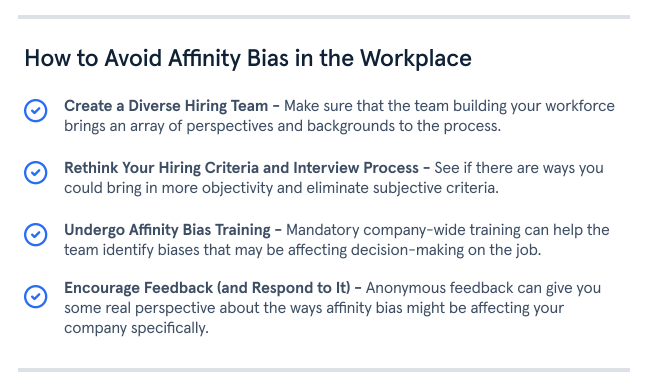
Unconscious bias in the workplace can take many forms, and no one is immune from allowing bias to affect their decision-making. Affinity bias is one of the most common types of unconscious bias, and it can also be one of the most damaging. But what is it, exactly?
Affinity bias is a tendency to favor those who have the same background, interests, and experiences as you. Without the proper training, it’s not always easy for people to identify this bias within themselves. However, it can be detrimental to your organization’s efforts to foster diversity and inclusion.
Fortunately, there are ways to help yourself and your team better identify your own affinity bias so you can prevent it from negatively affecting your decision-making in the workplace.
What Are the Negative Impacts of Affinity Bias?
What is affinity bias likely to do to your workplace culture if left unchecked? Here are just a few of the most common negative effects.
Less Diversity and Inclusion
Fostering a diverse, equitable, and inclusive environment not only promotes equality but also directly benefits your organization’s bottom line. Studies have shown that companies that prioritize and implement diversity are 21% to 33% more likely to outperform competitors that don’t.
Unfortunately, affinity bias is often one of the biggest obstacles preventing organizations from fostering DEI in the workplace.
If your hiring team unconsciously favors people with similar backgrounds and life experiences, odds are your workforce will lack diversity. And if your team tends to gravitate toward those who are similar to them, the diverse members of your workforce can feel alienated and less included.
Poor Company Culture
If your organizational operations are shaded by affinity bias, then those who are not benefitting from it will likely lose morale, as well as any sense of loyalty to your company. This in turn has a wider effect on the company culture, potentially resulting in a toxic work environment — which can make it 10 times more likely that your employees will quit.
Team members will cease feeling like equals when affinity bias tells them they are not. They will get the sense that there is no hope for professional growth and, therefore, no reason to remain engaged and productive — or to remain with your company at all.
Less Innovation
According to a study published in the European Journal of International Management, there is evidence of “significant associations between board diversity and three forms of innovation.” Those three forms of innovation include product, organizational, and marketing innovation.
It takes a wide range of minds with different backgrounds and perspectives to foster real innovation.
Increased Liability
Though they may be unconscious and unintentional, those unchecked biases can be incredibly costly in more ways than one.
Affinity bias has the potential to escalate to — or at the very least be interpreted as — discrimination in the workplace. This, of course, increases your liability risk and can threaten your company’s reputation.
How to Avoid Affinity Bias in the Workplace
There are many ways to better identify your affinity biases in order to overcome them and foster a more diverse and inclusive workplace. Here are just a few.

Create a Diverse Hiring Team
If you want your workforce to be as diverse and inclusive as possible, you should make sure that the team building your workforce brings an array of perspectives and backgrounds to the process. A diverse hiring team can act as a form of checks and balances to prevent affinity bias from playing a role in hiring decisions.
Rethink Your Hiring Criteria and Interview Process
Your hiring criteria may be supporting your affinity bias more than you know. Take a close look at it in order to determine how objective it really is. If you find that there are ways you could bring in more objectivity and eliminate subjective criteria, then take the time to make those changes.
There’s also a chance that your interview process is shaded by affinity bias. If you want to reduce bias in your interviews, make sure your questions — and the way you assess candidates’ answers — are as inclusive and objective as possible.
Undergo Affinity Bias Training
Your whole workforce, including you, should go through mandatory training to help you identify your own affinity biases and any other biases that may be affecting your decision-making on the job. Simply making your team aware of these things can go a long way toward overcoming the problem.
Encourage Feedback (and Respond to It)
Allowing your workforce an opportunity to provide feedback anonymously can give you some real perspective about the ways affinity bias might be affecting your company specifically. However, if you don’t take that feedback seriously and make changes based on what you’ve learned, it winds up being an empty gesture.
Identifying and Overcoming Affinity Bias Is Crucial for a Strong Workplace Culture
Having your own affinity biases is not inherently a terrible thing. In fact, everyone has them in some form or another. However, it is still your responsibility to learn how to identify those biases and keep them out of the workplace.







